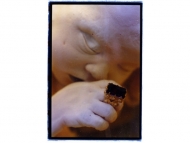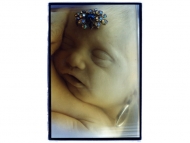
Iliya Chichkan Sleeping Princess 
Iliya Chichkan Sleeping Princess
EXHIBITION
1999 EST-OUEST festival, DIE, France
1999 LE QUAI Art School, MULHOUSE, France
2000 THESSALONIKI CONTEMPORARY ART CENTRE, Greece
ARTISTS: SERHIY BRATKOV, VASILIJ CAGOLOV, VADIM CHECKORSKY, ILIYA CHICHKAN, ALEXANDER HNILITSKI, ALEXANDER KHARCHENKO, VIKTOR KOTCHETOV, MIROSLAV KULCHITSKY, BORIS MIHAILOV, ANDREY MOSKVICHEV, E. MUKHOID, MIHAIL SCHEVCHENKO, ALEXANDER SHEVCHUK, SERHIY SOLONSKY, VASILY RYABCHENKO, IVAN TSUPKA
CURATORS: MARTA KUZMA, ART CRITIC, JEAN-CLAUDE SCHENKEL, DIRECTOR OF QUAI – ART SCHOOL OF MULHOUSE AND UPPER ALSACE
Contemporary photography in Ukraine has undergone a twofold evolution. Indeed, people who traditionally belonged to the photography scene during the Soviet period followed a different path from the artists trained in the various art academies. The tradition of photography and its application outside reportage does not originate from the artists usually cited and considered as the founders of the dissident artistic movement in Ukraine.
Photography developed, almost essentially and as an almost isolated phenomenon, in Kharkiv, a city in the east of the country. This avant-garde movement launched in the late 1960s never stopped evolving, unlike painting, which did not take part in any non-formalist movement during the Soviet period. The Kharkiv photographic movement formed by the Vremya group, whose members included the famous photographer and artist Boris Mihailov, began as a popular organization, like other organizations that were trying out a type of coveted discourse and exhibition outside the officially accepted framework.
It was not simply a counter-culture movement but an attempt to approach photography as a means of bringing, through an effort of “innervation”, reality seen through the lens into the heart of an apparently anaesthetized social structure.
In the Soviet Union, photography was reserved for designated individuals who used their cameras only for official and governmental purposes.
Photographers in Kharkiv were therefore forced to use mostly standard images of innocuous scenes representing the industrial and economic infrastructure (workers, means of transport and buildings). They often retouched these pictures by changing and demarcating the colours.
The photography that emerged after Glasnost, in a highly regionalized Ukraine, was the result of the meeting of two camps: the engineers who became artists in Kharkiv and the painters who became installation artists in cities like Kiev and Odessa. The movement born in Kharkiv, a former “enclave of photography”, took a much more antagonistic stance, setting itself the goal of creating a forum for photography as an art form, thanks to the efforts of groups such as The Fast Reaction Group (featuring the work of Serhiy Bratkov and Serhiy Solonsky).
In other cities, the Art Institute’s newly graduated students translated their interest in film into “situations” which they rendered first on canvas and then through photographic techniques. Artists such as Iliya Chichkan from Kiev began to present black subjects in large-format photographs, which they then painted with sepia or other paints. In contrast to Kharkiv, photography became a new path for artists seeking another dimension to their work.
To depict precisely what constitutes the specificity of the tradition and development of photography in Ukraine is to understand the importance that artistic photography has always had, both historically and currently, in relation to the predominance of documentary photography. In other words, despite the retouching of the image or the staging, photography remains marked by reality and the critique of society.
Marta Kuzma